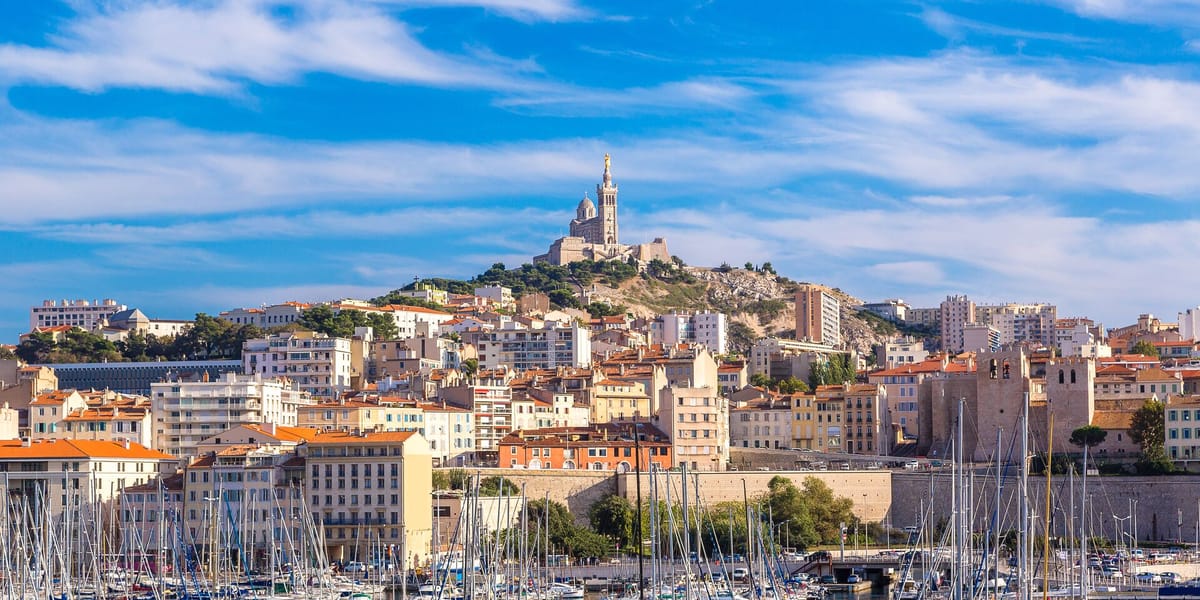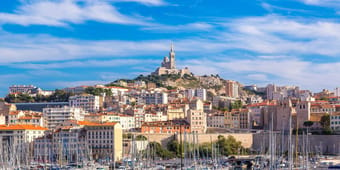
Flights to Marseille with Air France from CAD 793*
expand_more
1 Passenger, Economy
expand_moretoday
today
*Modifying this information may result in a different fare
Find your flight to Marseille
flight_takeoff
flight_land

Montreal (YUL)to
Marseille (MRS)01/17/2026 - 01/20/2026
From
CAD 793
Seen: 6 hrs ago
Round-trip
Economy

Montreal (YUL)to
Marseille (MRS)03/26/2026 - 04/16/2026
From
CAD 799
Seen: 6 hrs ago
Round-trip
Economy

Montreal (YUL)to
Marseille (MRS)03/26/2026 - 04/23/2026
From
CAD 799
Seen: 6 hrs ago
Round-trip
Economy

Montreal (YUL)to
Marseille (MRS)03/19/2026 - 04/02/2026
From
CAD 799
Seen: 4 hrs ago
Round-trip
Economy

Montreal (YUL)to
Marseille (MRS)03/19/2026 - 04/09/2026
From
CAD 799
Seen: 4 hrs ago
Round-trip
Economy

Vancouver (YVR)to
Marseille (MRS)04/03/2026 - 04/17/2026
From
CAD 898
Seen: 5 hrs ago
Round-trip
Economy

Vancouver (YVR)to
Marseille (MRS)02/06/2026 - 02/09/2026
From
CAD 899
Seen: 5 hrs ago
Round-trip
Economy

Vancouver (YVR)to
Marseille (MRS)02/06/2026 - 03/06/2026
From
CAD 899
Seen: 5 hrs ago
Round-trip
Economy

Vancouver (YVR)to
Marseille (MRS)02/03/2026 - 02/06/2026
From
CAD 899
Seen: 5 hrs ago
Round-trip
Economy

Vancouver (YVR)to
Marseille (MRS)02/10/2026 - 03/10/2026
From
CAD 899
Seen: 5 hrs ago
Round-trip
Economy

Québec (YQB)to
Marseille (MRS)02/25/2026 - 03/25/2026
From
CAD 1,473
Seen: 1 day ago
Round-trip
Economy

Québec (YQB)to
Marseille (MRS)02/23/2026 - 03/23/2026
From
CAD 1,473
Seen: 1 day ago
Round-trip
Economy

Québec (YQB)to
Marseille (MRS)02/25/2026 - 03/18/2026
From
CAD 1,473
Seen: 1 day ago
Round-trip
Economy

Québec (YQB)to
Marseille (MRS)03/02/2026 - 03/30/2026
From
CAD 1,473
Seen: 4 hrs ago
Round-trip
Economy

Québec (YQB)to
Marseille (MRS)03/10/2026 - 03/31/2026
From
CAD 1,473
Seen: 6 hrs ago
Round-trip
Economy

Toronto (YYZ)to
Marseille (MRS)03/23/2026 - 04/13/2026
From
CAD 855
Seen: 6 hrs ago
Round-trip
Economy

Toronto (YYZ)to
Marseille (MRS)03/24/2026 - 04/07/2026
From
CAD 855
Seen: 6 hrs ago
Round-trip
Economy

Toronto (YYZ)to
Marseille (MRS)03/18/2026 - 04/08/2026
From
CAD 855
Seen: 4 hrs ago
Round-trip
Economy

Toronto (YYZ)to
Marseille (MRS)03/18/2026 - 04/15/2026
From
CAD 855
Seen: 4 hrs ago
Round-trip
Economy

Toronto (YYZ)to
Marseille (MRS)03/22/2026 - 04/19/2026
From
CAD 855
Seen: 4 hrs ago
Round-trip
Economy
*Fares displayed have been collected within the last 48hrs and may no longer be available at time of booking. Additional fees and charges for optional products and services may apply.
Check our flights to Marseille for the upcoming months
flight_takeoff
flight_land
From | To | Fare Type | Dates | Price |
|---|---|---|---|---|
| Montreal (YUL) | Marseille (MRS) | Round-trip / Economy | 01/17/2026 - 01/20/2026 | From CAD 793 Seen: 6 hrs ago |
| Montreal (YUL) | Marseille (MRS) | Round-trip / Economy | 03/26/2026 - 04/16/2026 | From CAD 799 Seen: 6 hrs ago |
| Montreal (YUL) | Marseille (MRS) | Round-trip / Economy | 03/26/2026 - 04/23/2026 | From CAD 799 Seen: 6 hrs ago |
| Montreal (YUL) | Marseille (MRS) | Round-trip / Economy | 03/19/2026 - 04/02/2026 | From CAD 799 Seen: 4 hrs ago |
| Montreal (YUL) | Marseille (MRS) | Round-trip / Economy | 03/19/2026 - 04/09/2026 | From CAD 799 Seen: 4 hrs ago |
| Vancouver (YVR) | Marseille (MRS) | Round-trip / Economy | 04/03/2026 - 04/17/2026 | From CAD 898 Seen: 5 hrs ago |
| Vancouver (YVR) | Marseille (MRS) | Round-trip / Economy | 02/06/2026 - 02/09/2026 | From CAD 899 Seen: 5 hrs ago |
| Vancouver (YVR) | Marseille (MRS) | Round-trip / Economy | 02/06/2026 - 03/06/2026 | From CAD 899 Seen: 5 hrs ago |
| Vancouver (YVR) | Marseille (MRS) | Round-trip / Economy | 02/03/2026 - 02/06/2026 | From CAD 899 Seen: 5 hrs ago |
| Vancouver (YVR) | Marseille (MRS) | Round-trip / Economy | 02/10/2026 - 03/10/2026 | From CAD 899 Seen: 5 hrs ago |
| Québec (YQB) | Marseille (MRS) | Round-trip / Economy | 02/25/2026 - 03/25/2026 | From CAD 1,473 Seen: 1 day ago |
| Québec (YQB) | Marseille (MRS) | Round-trip / Economy | 02/23/2026 - 03/23/2026 | From CAD 1,473 Seen: 1 day ago |
| Québec (YQB) | Marseille (MRS) | Round-trip / Economy | 02/25/2026 - 03/18/2026 | From CAD 1,473 Seen: 1 day ago |
| Québec (YQB) | Marseille (MRS) | Round-trip / Economy | 03/02/2026 - 03/30/2026 | From CAD 1,473 Seen: 4 hrs ago |
| Québec (YQB) | Marseille (MRS) | Round-trip / Economy | 03/10/2026 - 03/31/2026 | From CAD 1,473 Seen: 6 hrs ago |
| Toronto (YYZ) | Marseille (MRS) | Round-trip / Economy | 03/23/2026 - 04/13/2026 | From CAD 855 Seen: 6 hrs ago |
| Toronto (YYZ) | Marseille (MRS) | Round-trip / Economy | 03/24/2026 - 04/07/2026 | From CAD 855 Seen: 6 hrs ago |
| Toronto (YYZ) | Marseille (MRS) | Round-trip / Economy | 03/18/2026 - 04/08/2026 | From CAD 855 Seen: 4 hrs ago |
| Toronto (YYZ) | Marseille (MRS) | Round-trip / Economy | 03/18/2026 - 04/15/2026 | From CAD 855 Seen: 4 hrs ago |
| Toronto (YYZ) | Marseille (MRS) | Round-trip / Economy | 03/22/2026 - 04/19/2026 | From CAD 855 Seen: 4 hrs ago |
*Fares displayed have been collected within the last 48hrs and may no longer be available at time of booking. Additional fees and charges for optional products and services may apply.

Travel to Marseille
Whether you're looking for a last-minute Marseille (MRS) flight or planning a flight at a later date, take advantage of our lowest prices for your travel dates on this site. With our flights list you can easily find for the coming months the cheapest prices to fly with Air France to Marseille (MRS). You can also directly pick your departure date on our booking engine at the top of the page, if your trip to Marseille (MRS) is already scheduled.
Marseille - a sun-drenched city that's always been a cultural crossroads
The city of Marseille (population: 850,000) has been a major settlement on France's Mediterranean coast for over 2,500 years. Now the country's largest city after Paris, Marseille is reached by frequent flights from major Canadian cities such as Toronto and Vancouver (Vancouver - Marseille via Paris in as little as just under 12 hours).
Marseille has a Mediterranean climate, and is the sunniest major city in France. Springtime temperatures are very pleasant and the weather is generally drier than the autumn, so this is an ideal time to go. The time difference between Marseille and Canada is anything between 9 and 5 hours ahead, depending on Province.
Marseille was named Massalia by its founders, who were seafaring Greeks originally based on the south coast of Turkey. It passed successively into the hands of the Roman Empire, the Visigoths, the Counts of Provence and finally France. The city's strategic location and rebellious reputation led to the construction of the Fort St Jean, the Fort Saint Nicholas and the Château d'If (setting of the famous novel, 'the Count of Monte Cristo').
Much of Marseille's population has non-French roots, especially from Italy, north Africa, and even Armenia, Vietnam and the Comoros islands. This makes Marseille a great place to sample food from every corner of the globe. However, don't miss out on local Marseillais specialties like bouillabaisse (fish stew), tapenade (an olive and capers paste, delicious on bread), fougasse (a flat bread often filled with olives, anchovies or cheese) and anchoïade, a paste composed of anchovies, olive oil and garlic, which can be used as a dip.
The easiest way to get an overview of Marseille society over the past two thousand years is by a trip to the new MuCEM, the Museum of European and Mediterranean Civilizations. Located right beside the Vieux Port (the old harbour, itself worth a visit for its colourful fish market), this venue contains everything from icons to puppets to examples of traditional Slovenian gingerbread!
Marseille - stunning architecture, from hilltop churches to modernist housing schemes
Marseille's most visible landmark is without doubt the basilica of Notre Dame de la Garde. It was constructed on Marseille's highest point and naturally offers amazing views over the city. The church was built on the 16th century foundations of a fort, part of which can still be seen, as can the bullet marks which date from the city's liberation in 1944. The bell tower supports an enormous gilt statue of Mary and Jesus. On a much smaller scale are the charming fishermen's cottages of the Vallon des Auffes, a small fishing village surrounded by the city and a great place to unwind. Le Corbusier built one of the modern world's most influential designs just a few miles to the south, in the shape of 'la Cité Radieuse', a housing development of 337 apartments which is still lived in today. Exhibitions and theatrical performances take place on the building's flat roof.
The natural world has its own architecture, of course, and the 'calanques' (inlets of the sea) that punctuate the coast next to Marseille, are as dramatic as anything any human architect could create. These natural wonders can be visited on foot or by boat excursion. For more information on holiday extras and special offers, just check out the Air France site.
